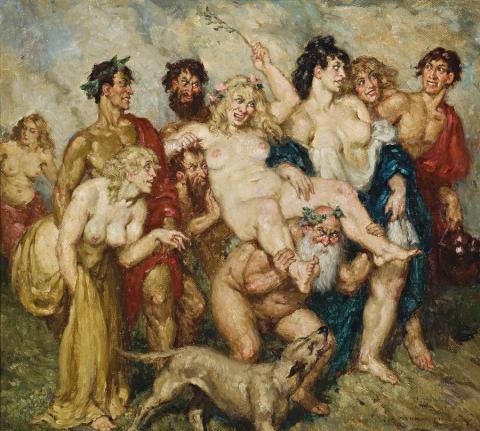SILENUS FINDS A COMPANION, c.1940
Norman Lindsay
oil on canvas
52.0 x 59.0 cm
signed lower right: NORMAN LINDSAY
Collection of the artist's daughter, Helen Lindsay Siau Thence by descent Private collection, United States of America
Throughout his life Norman Lindsay engaged his prodigious talents to crusade against wowserism, that puritanical fanaticism that had Australia in its grip at the time. Gifted as a painter, printmaker, and writer, Lindsay called upon his extensive knowledge of history and the classics to satirize the spoilsport, celebrating the human body in all its naked beauty and the pursuit of earthly pleasures. His familiarity with the gods and goddesses of ancient Greek and Roman mythology was considerable, his paintings and prints often focusing on the bodily delights of Venus goddess of love. There was also more than a touch of the femme fatale in his depictions of women, of men in the thrall of a Junoesque nude, others bewitched by a sorceress, a royal cavalier captivated by a cleavage, and a bloodthirsty pirate king succumbing to a black-haired beauty. He also had teetotallers in his sights, revelling in the joys offered by Bacchus the god of wine, as in Silenus Finds a Companion, and numerous other works, such as Procession 1951 and Revellers, devoted to the Bacchanalian rites and pleasures. Spring's Innocence 1937, acquired by the National Gallery of Victoria in 2002, provides a kind of 'before' to the 'after' of Silenus Finds a Companion. - the beginning of the Bacchanalian festival, compared with the coming orgiastic pleasures at its height.
Bacchus, or Dionysus as he was known to the ancient Greeks, was the son of Zeus and Semele. Youthful in appearance, he often held grapes or a cup of wine, and sometimes the thyrsus, a rod encircled with vines of ivy. Accompanied by a collection of male and female votaries, Satyrs and Maenads, they were often intoxicated and danced and processed around him. His chief companion was Silenus, a plump and jolly old man, usually intoxicated and often represented riding on an ass. Lindsay's representation of him is typical; but there may some inverted irony in showing Silenus being ridden by an equally plump and jolly woman. She, not Silenus, is crowned with flowers, and holds aloft what might be loosely interpreted as the thyrsus of Bacchus. While other male members of the Bacchic entourage have their women, they readily support Silenus in his endeavours. The colours and rollicking composition are in perfect harmony with the subject, all carried away by the delights of wine to amorous pleasures. While most of Lindsay's works in this genre involve youth in all its fecund beauty, Lindsay shows in this painting that he has not forgotten the aged and their ongoing desires. The prominence of the dog, however, is a curiosity. For Fido is ever the symbol of fidelity " perhaps of Silenus to Bacchus, now extended to his female companion?
DAVID THOMAS
